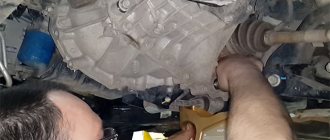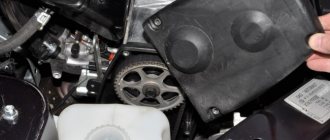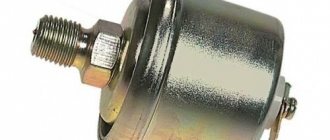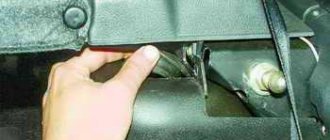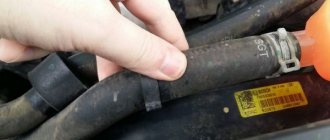The gearbox is one of the most complex and expensive components of a car, requiring increased attention, especially with sudden changes in operation. If the manual transmission in the Kia Rio 3 begins to “bite” when switching, there is gear slipping, and uncharacteristic sounds appear in the automatic transmission or the car jerks while driving, you should immediately contact a car service center; perhaps the reason lies in a lack of or contamination of the oil.
How much oil to pour into a Kia Rio box?
The volume of oil in the box depends on the type of transmission and year of manufacture of the car. Let's start with the less demanding mechanics and continue with the Kia Rio automatic.
How much oil is in a manual transmission?
2000-2005 year of manufacture (1.3i, 1.5i 16V): 2.8 liters GL-4+ 75W-90 approval.
2005-2011 year of manufacture (1.4i 16V, 1.6i 16V): 1.9 liters GL-4+ 75W-90 approval.
2005-2008 year of manufacture (1.5 CRDi): 2 liters GL-4+ 75W-90 approval.
2011-2017 year of manufacture (with a 1.4 or 1.6 engine, box model M5CF1-1): 1.9-2 liters type SAE 75W/85 API GL-4 TGO-7 (MS517-14).
2011-2017 year of manufacture (with a 1.6 engine, box model M6CF1): 1.8 liter type SAE 75W/85 API GL-4 TGO-7 (MS517-14).
How much oil is in a Kia Rio automatic transmission?
2000-2005 year of manufacture (1.3i, 1.5i 16V): 5.9 liters GL-5 80W-90 approval.
2005-2011 year of manufacture (1.4i 16V, 1.6i 16V): 6.1 liters GL-5 80W-90 approval.
2005-2008 year of manufacture (1.5 CRDi): 6.3 liters GL-5 80W-90 approval.
2011-2017 year of manufacture (with engine 1.4 or 1.6 box model A4CF1): 6.8 liters type GENUINE DIAMOND ATF SP-III or SK ATF SP-III.
2011-2017 year of manufacture (with a 1.6 engine, box model A6GF1): 7.3 liters type SK ATF SP-IV, MICHANG ATF SP-IV, NOCA ATF SP-IV, Hyndai Genuine ATF SP-IV.
Checking and, if necessary, changing the oil in the Kia Rio gearbox is carried out every 30,000 km. mileage, in accordance with the maintenance schedule for KIA cars from representatives of KIA Motors RUS LLC. Rio drivers recommend changing the automatic transmission oil every 45,000-60,000 km. mileage, in manual transmission every 90,000-120,000 km. mileage (with a mileage of 150,000 km, it is necessary to change).
How much does a box cost for a Kia Rio?
Failure to comply with the service conditions may well lead to the breakdown of such a complex unit as a car transmission.
Automatic transmission on Kia Rio 1st and 2nd generations costs from 25 to 40 thousand rubles. Manual transmission is 2 times cheaper - from 10-12 to 18 tr.
An automatic transmission on Kia Rio 3 and 4 costs from 30 to 50 tr, a manual transmission, on average, will cost 15-20 tr.
kiarioclub.ru
Why is there oil in the gearbox and does it need to be changed?
The manual transmission or automatic transmission of any car is factory filled with transmission oil, which performs important functions.
Oil in a manual transmission is needed for:
- reducing the friction force of metal elements, as well as protecting them from corrosion and premature wear;
- removal of excess heat from rubbing parts to avoid overheating, deformation and jamming of gears;
- reducing noise and vibration;
- reducing the shock load on the box elements;
- reducing energy losses due to friction.
For automatic transmissions, oil performs the same functions as for manual transmissions, but there is a main feature - if it is absent from the automatic transmission, the car will not even move, since it transmits torque from the engine to the wheels.
Car manufacturers claim that transmission oil changes are not necessary throughout the entire service life. This is explained by the fact that the average service life of a gearbox is 10 years, but usually they last much longer, so checking the condition of the gearbox oil and replacing it is necessary.
What kind of oil should be poured into the mechanic's box on the Kia Rio 3?
Among analogues, the most suitable oils are Shell brand. Mobil, Toyota Gear Oil, Castrol, ZIC, Lukoil TM-5 of the same viscosity SAE 75W-85 are also suitable.
The volume of oil in the manual transmission that will be required for replacement is 1.9 liters.
What kind of oil should I pour into the automatic transmission of a Kia Rio 3?
As analogues, automatic transmissions can be filled with Total, Mobil, Chevron oil with a specification corresponding to the original.
For a complete replacement you will need about 7 liters of oil.
How to check the oil level in a Kia Rio 3 box?
To check the oil in different types of boxes, you first need to place the car on a flat surface.
To determine the level in a manual transmission you need:
- Turn off the engine.
- Wait 2-3 minutes, let the grease drain and cool slightly.
- Unscrew the neck, insert the dipstick.
- Determine the level based on the Min and Max marks.
- Screw the neck.
In the Kia Rio 3 automatic transmission, checking the oil has difficulties and nuances, since the boxes come with or without a dipstick. The measurement should be carried out in the same way as in the case of a manual transmission - with the engine turned off.
Automatic transmission with dipstick:
- Unscrew the neck, insert the dipstick.
- Take out and determine the level, the norm of which is between Min and Max.
- Screw the neck back on.
This procedure must be done several times with a difference of at least 1 day. This is required because there are a lot of cavities in the automatic transmission that are filled with oil, depending on the situation. Therefore, the level during the first check may be unreliable.
In an automatic transmission without a dipstick, you cannot check the level in the usual way; it can only be set by adding oil. Such a box has an overflow system, consisting of a tube in the drain hole and a plug, when unscrewed, excess liquid flows out and only the required volume remains.
To set the correct oil level in an automatic transmission without a dipstick, you need to:
- Hang the slightly warmed up car on a lift in a horizontal position. If the trip was long, then you need to wait until the liquid cools down a little.
- Unscrew the drain plug, and place a container under it in advance, as some of the oil lubricant that got into the tube during operation of the automatic transmission will leak out. By examining it, you can determine the degree of contamination.
- Add about 100 ml of new oil. It should start dripping from the tube. If this does not happen, then you need to add a little more until the liquid appears in the tube.
- Wait until the excess flows out and screw the lid back on.
Such a complex system is made to prevent oil overflow, which is extremely harmful for this type of gearbox.
What happens if you don’t promptly monitor the oil level and change it?
For a manual transmission, untimely oil change will lead to the following:
- gears will be changed with great difficulty;
- chips from unlubricated parts will fall into the filter and clog it;
- there will be a strong hum while driving;
- The clutch or sprockets in the gearbox may break.
This may affect the automatic transmission in the following ways:
- increased fuel consumption;
- incorrect gear shifting;
- Automatic transmission breakdown until replacement.
Gearbox oil is just as important as it is for a car engine. It prevents the destruction of parts, extends the service life of the unit, and promotes its proper operation. The main thing is to monitor the condition, as well as the level of transmission oil, and then the box will last for many years.
Source: https://KiaRioClub.ru/obsluzhivanie/4757-maslo-v-korobkah-kia-rio-3-mkpp-i-akpp.html
Changing the oil in a Kia Rio manual transmission: when, why and how much?
Good day! I have a Kia Rio 2010, mileage - 100,000. Do I need to change the oil in the manual transmission? (Sasha)
Sasha, good afternoon. We have studied your question and want to give some tips on changing the transmission fluid.
What do you need to know about changing transmission oil in a Kia Rio?
According to the technical manual for your vehicle, the fluid in the manual transmission is filled for the entire service life of the car, that is, its replacement, according to the manufacturer, is not necessary. However, as practice shows, any consumable material will lose its characteristics over time. Therefore, the lubricant in the unit should be replaced at least every 90 thousand kilometers. That is, in your case it’s time to change the lubricant.
As for the direct choice of consumables, it is recommended to fill the Kia Rio with “synthetics” that meet SAE 75W/85 or 75/90 tolerances according to API GL-4. In order to ensure the most efficient operating characteristics, we recommend using Hyundai transmission fluid.
Original transmission oil for Kia Rio
As for directly replacing consumables, the process is described below.
It is recommended to change the lubricant after a short trip so that the liquid spreads throughout the system and leaves it faster:
- First you need to find the filler plug; it is located in the front of the unit.
- After this, using a wrench, you need to unscrew the control hole cover, but not completely, but somewhere in half. If the oil level in the system is normal, then the liquid will come out quickly, so immediately place a container to collect the waste. When the bulk of the waste substance has already drained, the plug can be completely unscrewed. Then unscrew the drain cap as well.
- Since this is the first fluid change for your car, we will not describe the procedure for flushing the transmission. But in the future it is still better to do washing, especially if you do not always use the same oil. When all the old grease has come out, screw on the drain cap.
- New consumables are poured through the appropriate neck, but this is not as easy to do as it might seem at first glance. Therefore, you will need a syringe or watering can through which you will pour lubricant into the system. The filler neck must be cleaned of dirt before use.
Video “How to change TM in Kia Rio”
For more information about replacing transmission lubricant, watch the video (by Dmitry Kapranov).
avtozam.com
Replacement process
You can find answers to many questions on the Internet; motorists actively share their experiences on specialized forums. If you study these recommendations, after a certain period of time you can become a real master yourself, whose vehicle will never encounter serious technical problems. Today we will look at how to replace the transmission fluid in the gearbox of a Kia Rio car.
Frequency of work
The technical manual states that the transmission oil poured in by the automaker will last for the entire service life. However, as reality shows, over time, transmission fluid loses its characteristics, as a result of which the risk of damage to the main units increases. If you do not change the oil in the manual transmission, then soon the car will begin to creak, become difficult to obey, and after some time will not budge at all.
Do not forget that the technical tests, based on the results of which the automaker wrote such conclusions in the manual, took place in conditions that differ sharply from Russian realities. For this reason, we recommend replacing the TM after the vehicle has covered about 90 thousand kilometers. If your car has a manual transmission, then this figure decreases; the oil should be changed after 60 thousand kilometers. Some overly caring car owners prefer to replace them after a mileage of 30 thousand kilometers.
Level check
By the way, a shortage of transmission fluid in the gearbox can force you to carry out such a technical manipulation before the car has covered the specified distance. You can find out that this deficiency has occurred if you check the oil level correctly.
Open the hood, carefully inspect the space, after which you will easily find the dipstick. Remove it, use a rag, and wipe the dipstick to remove old oil marks. We only recommend paying attention to the condition of the rag itself. You cannot use it if it contains lint on the surface, since such lint, if it penetrates the gearbox, can cause a technical failure of the unit.
After you clean the surface of the dipstick with a rag, immerse it in the filler hole, then remove it and carefully look at where the oil trace is located. It is very important that its location is the space between two indicators on the dipstick (maximum and minimum). If the oil trace is below the minimum line, it means that there is a clear lack of gear oil in the gearbox. You should be concerned about eliminating such a deficiency.
Which oil to choose
As soon as you have identified a shortage of transmission oil, or the time has come to replace it, first go to the auto store to purchase a new TM for pouring into the automatic transmission. Inexperienced car owners may panic because they are completely unfamiliar with mechanics and do not understand what kind of oil to fill in the Kia Rio 3. We will help you quickly get an answer to this question. In particular, the automaker recommends purchasing API GL-4, SAE 75W/85 oil for Kia Rio.
Amount of transmission oil for Kia Rio 2 and 3
It is important to understand what volume of transmission fluid you need in order to carry out such a technical procedure efficiently. Experienced car owners claim that for manual Kia Rio manual transmissions you will need to buy from 6 to 7 liters of oil. It all depends on what specific type of vehicle you are using. So, now understanding how much TM you need, feel free to go to the auto store, purchase the necessary consumables and replace the TM.
Tools for work
To carry out the replacement, you will need to purchase not only transmission fluid, but also a new oil filter, gasket, and sealant. You should also arm yourself with some tools that will make it much easier for you to carry out the technical procedure:
- heads;
- open-end wrenches;
- the container into which the waste will flow;
- rags;
- funnel.
Step-by-step instruction
After completing the preparatory stage, you can safely begin the practical implementation of the technical procedure. First, take your car for a short drive. This is required so that the units warm up and also allow the transmission fluid to warm up, as a result of which the waste will flow out easily.
After this, drive your car into the pit, unscrew the drain plug slightly, and place a container so that the waste flows into it. Be careful as old oil is hot and can cause serious burns if it comes in contact with your skin. As soon as the exhaust pressure decreases, unscrew the drain plug completely. After the old oil has drained out, tighten the drain plug.
If you previously poured a different type of oil into the gearbox, and now want to use a different option, then you will need to flush the gearbox to prevent mixing of two different fluids with “conflicting” parameters.
New transmission oil is poured through the filler hole. To make this task easier, use a funnel. After this, check the TM level using a special dipstick. If you are convinced that the amount of oil poured in is correct, start the engine and drive your car, and then re-measure the TM level. This completes the procedure.
You are convinced that it is easier to perform many technical manipulations yourself, while saving money that would have to be spent on paying for the services of service station specialists.
What kind of oil to put in a Kia Rio 3 manual box
Changing the manual transmission oil of a Kia Rio 3 is quite simple and does not require any special skills. Failure to promptly change the oil in a manual transmission can lead to difficulty shifting gears. Therefore, the oil must be changed, and before it begins to lose its properties.
When to change, what and how much oil to fill in the Rio 3 manual transmission
The maintenance schedule does not specify the oil change interval for the gearbox. But it is better to check the oil level in the manual transmission at 60,000 km, and the recommended replacement interval is set at 120,000 km - for severe conditions.
To replace a 1.4 engine, 1.9 liters of new oil will be required. Recommended by the manual - HK MTF (SK), HD MTF (HKSHELL), original Kia manual transmission fluid (API GL-4, SAE 75W/85).
How to change the oil in a manual transmission Rio 3
The car should be installed on a pit, overpass, or the front part should be jacked up. Then place a container under the manual transmission drain hole, unscrew the bolt and drain the oil into the container. When it stops flowing, tighten the drain bolt.
Next, you need to unscrew the filler hole bolt, install a hose/tube there, bring the other end up and fill in new oil. When clean oil begins to drip from the inspection hole, tighten the bolt.
eurasia-avto.ru
Functions of lubricants
Kia Rio transmission oil performs the following functions:
- protection of rubbing elements from wear;
- reduction of energy losses due to friction;
- heat sink;
- significant reduction in noise and vibration of gear wheels;
- reducing the shock load on gearbox elements.
Before checking the oil level in the manual transmission, you should place the car on a level surface.
After this, the following steps must be completed:
- Wait two minutes from the moment the engine is turned off.
- Allow the gear lubricant to cool.
- Prepare the necessary tools to open the neck.
- Lower the dipstick into the neck and determine the amount of liquid.
- Close the neck.
A manual transmission requires diagnostics of the lubricant level every ten to fifteen thousand kilometers. If there is a shortage of lubricant, add the required amount.
If there is a shortage of lubricating fluid in the gearbox system, the driver may notice:
- difficult gear shifting;
- heavy travel of the manual transmission lever;
- slipping when changing gear.
The service life of factory lubricant largely depends on driving style and external factors.
So, in order for the lubricant to last as long as possible, the following points must be taken into account:
- Newness of the car. On older car models, there are significant gaps in the manual gearbox, which contribute to the faster deterioration of the lubricant.
- Terms of Use. In the presence of cold winters, condensation enters the lubricant and worsens its viscosity properties.
- Best before date. Each lubricant has its own expiration date, after which the antifriction parameters begin to decline.
Changing the oil in a manual transmission - logbook of the 2014 KIA Rio on DRIVE2
Still, I decided to do this. After reading a book on the car, I saw that under normal operating conditions the oil does not change at all, that is, it seems to last forever. In difficult conditions, change it at 120,000 km. After surfing the Internet and talking with competent people, it became clear that there is no eternal oil, and it will not last 120,000 km. Replacement in the interval of 60-80 thousand km. optimal.
The odometer shows 57,340 km and winter is ahead, I think it’s a good time to change the oil in the box before the cold weather sets in.
I change all fluids according to the book and based on severe operating conditions, namely:
1) Regular trips over short distances 2) Long-term operation of the engine in idling mode (warming up the engine in winter) 3) Operation on dusty, uneven roads 4) Operation of the vehicle in areas where salt or other substances that cause corrosion are often used to treat roads, or in conditions of very low temperatures5) Driving with frequent stops
6) Operation in very cold weather
Who is interested in more details about the operating conditions on pages 7-17 of the instructions for the KIA RIO.
Now about the oil. MOTUL GEAR 300 75W-90 The instructions say that the oil viscosity should be 75W-85, but there are very few oils with this index. That's why I took 75W-90, the difference with 75W-85 is small. After the replacement, the impressions are positive. Switches softer. Let's see how it performs at -30
Good luck on the roads))))
www.drive2.ru
How to change transmission oil?
Most car manufacturers of various classes claim that the transmission lubricant poured into the gearbox at the factory does not need to be changed for the entire service life of the vehicle.
However, as practice shows, such a statement is not always true and quite often the oil in the Kia Rio gearbox needs to be changed. This procedure is carried out mainly after long-term use of the car or when irregularities in the operation of the gearbox are detected.
What kind of automatic transmission, manual transmission is installed on the Kia Rio 3
| Model | Year of issue | type of drive | Modification |
| Kia Rio 3 | 2011 — 2015 | Front | F4A-EL |
| Kia Rio 3 | 2011 – 2015 | Front | F4A-EL |
| Kia Rio 3 | 2011 – 2015 | Front | A4AF3/A4BF3 |
| Kia Rio 3 | 2011 – 2015 | Front | A4AF3/A4BF3 |
| Kia Rio 3 | 2011 — 2015 | Front | A4AF3/A4BF3 |
The first two modifications are of a mechanical type, the next three are of an automatic transmission type.
How to change the oil in an automatic transmission in a Kia Rio with your own hands?
11/30/2017 The Kia Rio car is a common vehicle on the automobile market, which is equipped with a reliable engine and transmission. They are characterized by an increased service life. Since 2011, the 3rd generation of this foreign car has become available. Kia Ceed is a worthy competitor to the Rio model. In terms of power, the latest version of the Ceed is superior to the Kia Rio 3. However, in terms of acceleration speed and fuel efficiency, the advantage is on Rio's side. Each of the presented Kia modifications must be properly cared for by the driver. In particular, this is an automatic transmission oil change. It should be noted that the 2015 Rio model may have an automatic transmission (4 or 6 speed).
Changing the oil in an automatic transmission
To avoid premature breakdowns of the speed box. The owner of a foreign car must adhere to certain rules for caring for it. On the Kia Rio 2014, the need to change the oil occurs at 50,000 km. By this time, the driver may encounter problems such as jerking when changing gears, or a hum from the gearbox. According to the regulations, the automatic transmission oil in the Kia Sid JD must be changed after 60,000 km.
How to change oil on Kia Rio (automatic)
Changing the oil in the Kia Rio 2011 automatic transmission is carried out in a number of stages:
For beginners, the replacement procedure may take about an hour. Before starting work, the car should be warmed up. The frequency of replacement depends directly on the quality of fuel used, as well as on the nature of the ride.
How much automatic transmission oil does a Kia Rio need?
For the Rio model, you can use SK ATF SP-III fluid. This fuel is also suitable for Kia Sid automatic transmissions. Untimely replacement of fuel can cause the high-speed transmission to fail prematurely. Changing the oil in an automatic transmission in a Kia can be entrusted to either professionals or done independently.
Manual transmission service
According to the regulations, an oil change in the Kia Rio mechanics should not be required at all, that is, it is filled at the factory for the entire service life of the car. As you understand, nothing lasts forever, therefore the transmission fluid must be periodically changed to new one.
Experts advise performing maintenance every 90 thousand kilometers to avoid serious damage to the unit.
Level check
Castrol 75W-85Castrol 75W-85
Every 10-15 thousand kilometers you need to check the lubrication level in the manual transmission. This is not difficult to do: you need to climb under the car, drive it onto a lift or hole, and unscrew the inspection hole bolt. The liquid level in it should be up to the edge. If it is lower, be sure to add the missing volume to avoid wear of the expensive unit.
What is needed for replacement?
In Kio Rio, changing the oil in a manual transmission requires a small set of tools and fresh fluid. Gear lubricant must be selected with APIGL4 SAE 75W-85 specification from any trusted brand - Shell, Mobil, ZIC, Castrol, etc.
From the tools you will need wrenches or sockets for 14 and 17, a special syringe, rags, a container for draining old oil.
Let's start replacing
Control hole
In order for the oil change in the Kia Rio box to be successful, you must act strictly according to the instructions. Locate the plug on the front of the level control unit and unscrew it halfway. If the level is normal, at a temperature of about 50 degrees the oil should flow out. With something in place, unscrew the filler bolt all the way.
Next, unscrew the drain plug, which is located at the lowest point - on the crankcase. Old oil should begin to flow out of it. Wait 10-15 minutes for the glass to be fully lubricated, then screw the bolt into place and use a special syringe to fill in new transmission fluid through the inspection hole.
Note that the plug has a sealing washer, which is recommended to be changed every time the drain bolt is unscrewed. Otherwise, smudges may form.
How to change oil in Kia Rio
Carrying out such a procedure is inevitable for any brand of car, regardless of the year of manufacture or manufacturer. For Kia Rio, it is recommended to change the engine oil after 15 thousand kilometers. In addition, the lubricant should be changed in manual and automatic transmissions.
About changing engine oil
We will not talk about strictly observing the mileage of the car for changing engine oil, since it can be significantly reduced. This depends on the operating conditions of the car, driving style, lubricant quality and other conditions. Changing the Kia Ria oil can be done at a service station or independently. To carry out this operation, you should prepare tools, rags, a drain container, engine oil, and other consumables. The owner will have to decide on a place to perform this procedure. It is advisable to have a garage with an inspection hole or an overpass. The choice of lubricant for the power unit requires special attention. It is advisable to use materials recommended by the machine manufacturer, but there are quite suitable lubricants of other brands. We will not recommend any brands; for this there are Kia Rio operating instructions, dealerships, and oil change stations. It is also important to choose the right lubricant filter for your car. Let's talk in more detail about how to change the oil in a Kia Rio engine. When all materials and tools for replacement are prepared, you can begin the procedure.
It is necessary to drain the waste only after the engine has warmed up. To avoid hand burns, it is best to work with gloves. Place the machine on an overpass or inspection hole, after which you can begin replacement.
The order of execution will be something like this:
After this, fill the new filter with engine oil to approximately half its volume, lubricate its gasket with the same lubricant and install the product in place. Important! If the brand of engine oil is changed, the lubrication system must be flushed. Now you can pour fresh oil into the crankcase of the power unit. Its level should reach the top “F” mark of the dipstick.
Typical problems with automatic transmission, manual transmission of Kia Rio 3, at what mileage they occur
Automatic transmission Kia Rio 3
| Mechanism | Signs |
| The brake band reaches its service life after 150 thousand km. | The clamps and the surface of the drum wear out. Signs: slipping, unstable operation, decreased power, periodic transition of the box to emergency mode |
| Friction wear | Signs: “knocking out” of gears while moving, shocks when switching to lower speeds, clutch slipping |
| Incorrect operation of the electronic control unit (ECU) | Voltage surges, loose terminal contact, resulting in a “Check Engine” error on the dashboard: P6545, P5499, P7327, P9420, P4636 |
| Premature wear of the torque converter unit | The reason is an aggressive driving style, “sporty” starts at traffic lights. Vibration appears in the gearbox, knocking, jolting when shifting to higher gears |
| Unheated transmission | Driving on an unheated transmission leads to premature wear of the valve body |
Manual transmission Kia Rio 3
Self-diagnosis without special equipment is not always effective. Sometimes, the defect “is located” much deeper, inside the box body.
It is important not to miss the moment of breakdown and promptly contact the service station for help from specialists. Still, the nature of mechanical breakdowns is simpler than that of an automatic transmission or a variator.
| Mechanism | Signs |
| The transmission does not engage when the rocker is pressed | The reason is insufficient oil level. When the lubricant does not completely wash the drive shaft. Stretching of a cable drive is less common during long-term operation without intermediate preventive maintenance. |
| There is a burning smell near the car | Insufficient amount of oil, increased operating temperature, as a result of which the rubbing surfaces stick. A number of European automakers install radiators - coolers similar to the automatic type to prevent overheating. However, this does not always help |
| When driving in neutral gear, noise, hum, vibrations are heard | The transmission needs to be dismantled, disassembled, and troubleshooting. Based on the diagnostic results, the technician makes a decision on the advisability of further use of the unit. Roller bearing wear is a common cause of noise. |
| Working out on clamps is the reason for speed loss | Worn drive gear and drive shaft are less commonly reported |
| Clutch jamming | The clutch disc does not disengage from the flywheel when the brake pedal is pressed. To give a final conclusion, it is necessary to conduct a diagnosis and disassemble it into its component elements. Cable stretching is also one of the reasons for jamming |
| Metal grinding, vibration | The reason is an unadjusted clutch, excessive wear of clutches and synchronizers |
| Constant hum when driving | Failure of roller bearings is the most likely cause of extraneous noise |
| Depressurization | Leakage of transmission oil leads to a decrease in the level of lubrication, an increase in operating temperature, jamming of the working surface and rubbing parts |
| "Check Engine" | The "Check Engine" indicator appears on the dashboard. |
To check the oil level, unscrew the filler plug on the gearbox housing. The level is sufficient if the lubricant begins to leak. Otherwise, we make up for the missing amount.
There is no need to ignore the dashboard signals. Malfunctions require prompt intervention by a service station technician. To decrypt, use a portable diagnostic scanner.
Most modern cars are equipped with digital sensors that monitor the technical condition of a particular unit online. Current information is displayed on the dashboard display.
As soon as the light comes on, be sure to turn off the engine, check the oil level, signs of depressurization, and mechanical damage.

